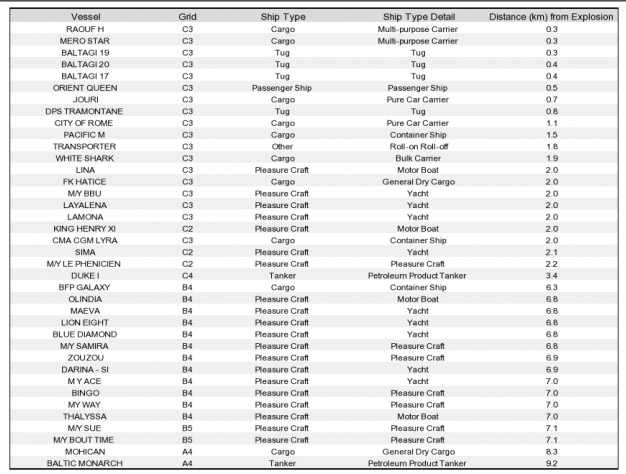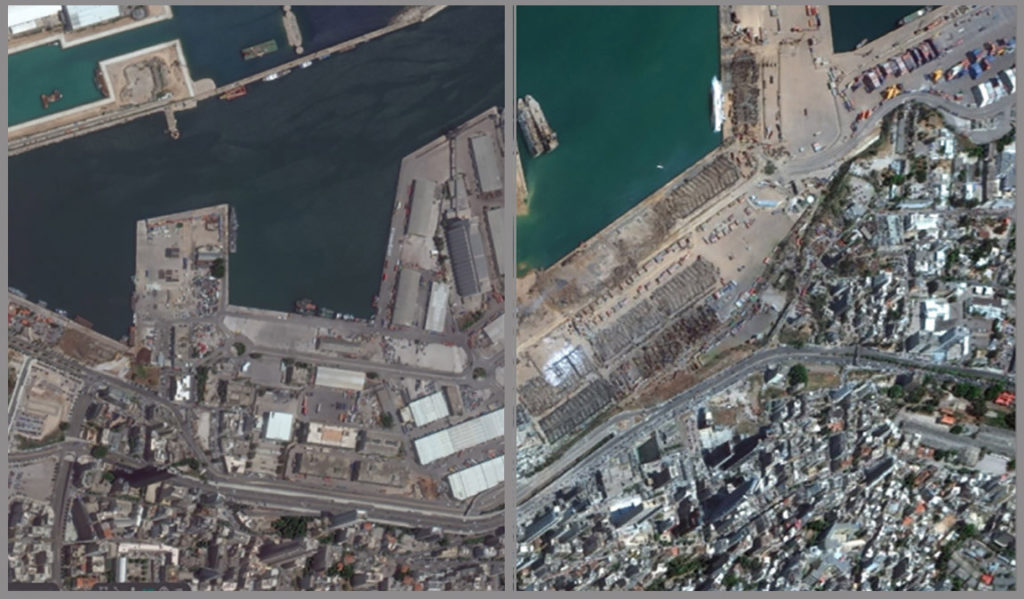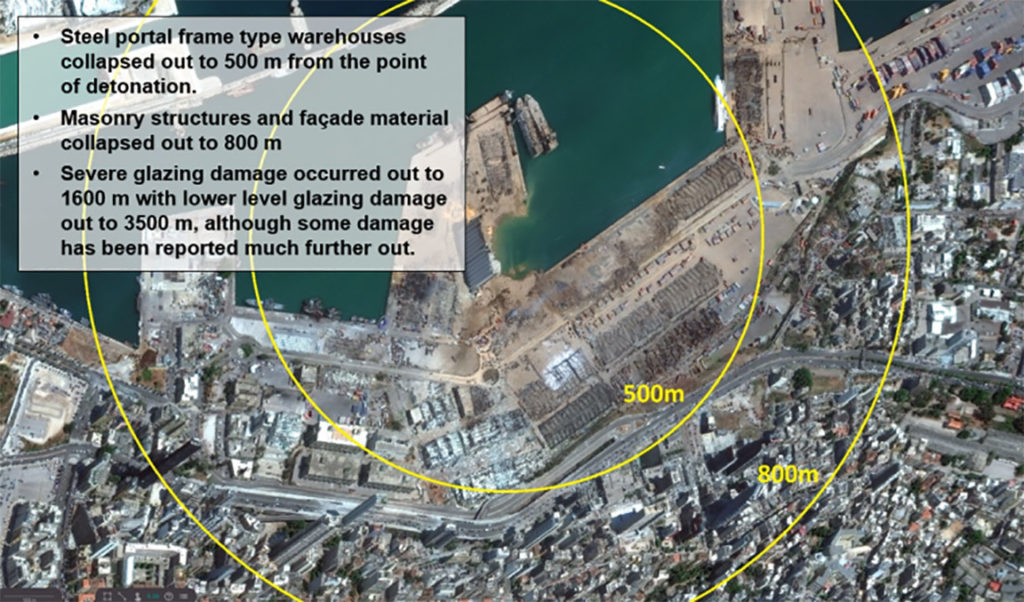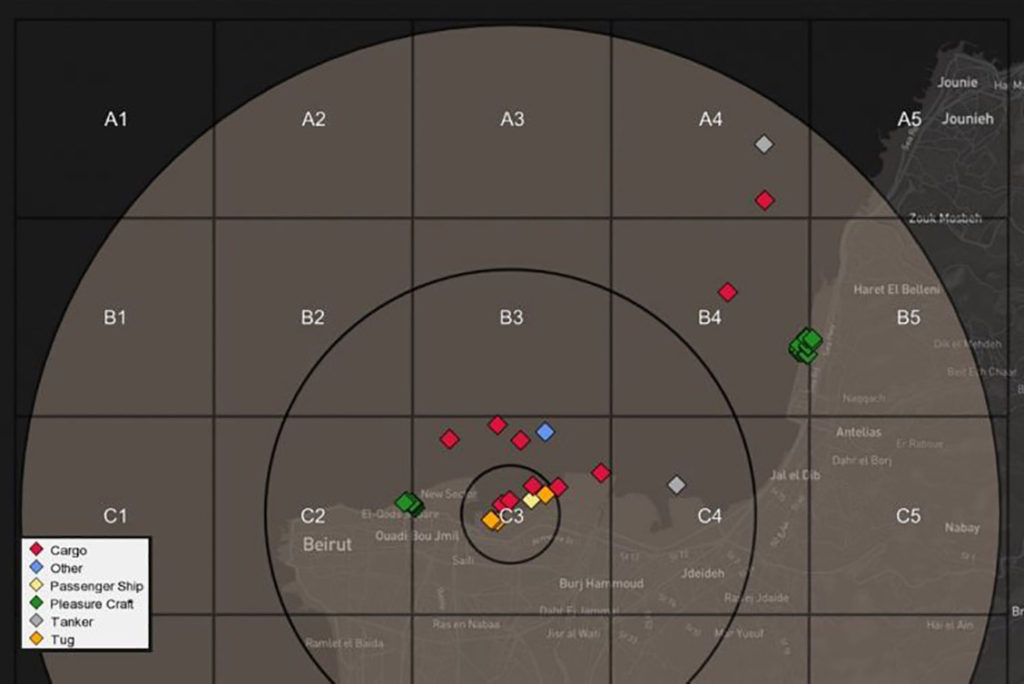Whilst the rescue effort is still in progress, the explosive event in the Port of Beirut that occurred on Tuesday 4 August tragically resulted in at least 137 fatalities, 5000 injuries and widespread damage across a large area of the city. Much of the port has been totally destroyed with a crater measuring 140 m in diameter, partial collapse of the grain silos, total collapse of warehouses and ships overturned. The blast damage to the urban area adjacent to the port has also been severe. The socioeconomic consequences for Lebanon will be significant, impacting a country that already faced economic and political challenges.
It has been reported that 2750 kg of ammonium nitrate had been stored at the port since 2013. Ammonium nitrate is an oxidising agent that, when combined with sources of fuel and an initiation, can result in an explosion. It is not yet clear what the fuel source was, but it is apparent that the main explosion was preceded by a number of fires and smaller explosions. It will take investigators some time to assess the explosive mechanism, but it is likely to be complex, imperfect and therefore not directly comparable to an idealised high explosive event that is typically assumed for insurance blast modelling scenarios. It may be that not all the material combusted or at sufficient speed to detonate, or that there was a series of near instantaneous explosive events. However, Guy Carpenter has considered the observed damage at distance from the explosion source and, from this has assessed the TNT equivalent to cause this level of damage. Comparison is also made against the 2015 Tianjin explosion. This will support the modelling of the impacts for an insured portfolio. Guy Carpenter has been supported by Synthetik in its consideration of blast effects on structures.
Observed Damage
Steel Portal Frame: For portal frames to collapse requires an impulse of approximately 3000 kPa-msec. We observe this damage at up to 500 m and assess that a 100 T TNT charge would cause this.
Masonry and façade cladding: For masonry and cladding to collapse requires approximately 2000 kPa-msec of impulse. At 800 m a 100 T TNT charge would cause this impact.
Glazing: With severe glazing damage reported at 1600 m, still extensive out to 3500 m and sporadic damage further out it is hard to justify as large a TNT equivalent. This suggests that the explosion lacked the energetic power of a full and instantaneous detonation from a solid homogenous explosive material, with effects at greater distances appearing diminished when compared to a TNT equivalent.
Insurance Considerations
The event is expected to incur losses to multiple lines. The Governor of Beirut estimated that the economic impacts would be in the region of USD 10-15 billion. There is still much uncertainty and speculation on the quantum of the insured loss.
The port is close to the centre of the city where retail and corporate real estate, as well as residential property, will have been affected. At the same time, property insurance levels remain relatively low in Lebanon, despite recent market penetration. The penetration for industrial exposures near the port and for commercial lines will be higher, which could impact some of the international insurance market.
From a Marine perspective, our vessel tracking capability found 40 vessels to be within a radius of 10 km of the blast. Ten vessels were within 1.6 km of the explosion, and we expect those vessels would have incurred damages. Many other vessels were within a radius where sporadic damage may have occurred.

There is still substantial uncertainty around the insured losses but Guy Carpenter’s early analysis suggests the total combined hull, cargo and port facility losses should be within USD 250 million. We will continue to monitor this, as more information becomes available to us.
Potential for Model Simulation
The Beirut Port explosion and Tianjin explosion were not unique events. Other very large explosions at industrial storage facilities have occurred previously and similar sites around the world face the same risk. It may therefore be prudent for insurance purposes to model such an event where industrial storage facilities are colocated with large insured values.
A number of techniques are possible from applying historic event footprints, simplistic large TNT equivalent blast models or applying more sophisticated techniques to model the built environment in greater detail, simulating ANFO (ammonium nitrate fuel oil) or suboptimal explosive events.

Sources: MAXAR, BBC News, Reinsurance News, Spire, Synthetik.
Sources: GC Capital Ideas




HGH Vs Steroids: Exploring The Key Differences And Risks
# HGH vs Steroids: Exploring the Key Differences and Risks
## Understanding HGH and Steroids
**What is HGH?**
Human Growth Hormone (HGH) is a naturally occurring hormone
produced by the pituitary gland, which plays a crucial role in growth, cell reproduction,
and overall development during childhood. Its levels typically decrease
as individuals age, leading some to consider supplements
or injections to counteract this decline.
**What are Anabolic Steroids?**
Anabolic steroids are synthetic substances designed to mimic the hormone testosterone.
These drugs are often used by athletes and bodybuilders to enhance muscle mass, strength, and performance.
Despite their popularity, misuse of these compounds has led to significant health
concerns and legal repercussions.
## HGH vs Steroids: Key Differences
**Mechanism of Action:**
HGH functions by stimulating growth processes in the body, promoting cell division and enhancing overall metabolism.
In contrast, anabolic steroids primarily work
by binding to androgen receptors, mimicking testosterone’s effects and directly increasing muscle protein synthesis.
**Applications:**
– **HGH**: Primarily used for treating growth hormone deficiencies, improving body composition through body recomposition,
addressing signs of aging, and boosting energy levels.
– **Steroids**: Widely utilized in sports for muscle mass
gains, strength enhancement, and performance optimization.
However, their use often leads to adverse effects due
to their potent androgenic nature.
## Potential Benefits and Side Effects
**HGH:**
– **Potential Benefits:** HGH can enhance metabolism,
support muscle growth, improve recovery time, and reduce signs
of aging.
– **Potential Side Effects:** Users may experience joint pain, high blood pressure,
and insulin resistance. There is also a risk of developing acute respiratory distress
syndrome (ARDS) in severe cases.
**Anabolic Steroids:**
– **Potential Benefits:** These steroids can lead to rapid muscle mass gains,
increased strength, and enhanced stamina.
– **Potential Side Effects:** The list of side
effects is extensive and includes liver damage, psychological disturbances, hair loss,
and hormonal imbalance. Long-term use can also result in testicular atrophy and
infertility.
## HGH vs Steroids: Legality
The misuse of both HGH and anabolic steroids is illegal without a valid medical prescription. The sale and possession of these substances
are strictly regulated, with penalties for those found in violation.
Additionally, the use of HGH can lead to failed drug tests, which often result
in disqualification from sports or other competitive activities.
## Weighing the Risks and Benefits
While both HGH and steroids offer potential benefits,
particularly in muscle growth and performance enhancement,
the risks associated with their misuse are substantial. Health complications,
legal consequences, and dependency issues highlight the dangers of their improper use.
It is crucial to consider these risks carefully before deciding to engage in their utilization.
## FAQs about HGH vs Steroids
**What’s the Difference Between Steroids and HGH?**
HGH is a naturally occurring hormone that supports growth, while anabolic
steroids are synthetic substances designed for muscle enhancement.
They function differently in the body but share similar
risks when misused.
**Can You Build Muscle With HGH?**
Yes, HGH can contribute to muscle growth, particularly in body recomposition, though it may not be as potent
as steroids in terms of mass gains.
**What Are the Negatives of HGH?**
The negatives include joint pain, high blood pressure, insulin resistance, and potential respiratory
issues. Misuse can also lead to failed drug tests.
## Conclusion
In summary, while HGH and anabolic steroids offer distinct benefits for muscle growth and
performance, their misuse poses significant health risks and legal consequences.
Athletes and individuals should be cautious, prioritizing natural approaches and seeking medical advice before considering these substances.
Remember, the risks far outweigh the potential gains
when it comes to these hormones.
**Recent Posts**
– The Importance of Proper Nutrition in Athletic Performance(#)
– Understanding the Role of Recovery in Sports(#)
– Enhancing Workout Efficiency: Tips and Techniques(#)
**Categories**
– Health & Fitness
– Sports Science
– Muscle Building
my site … How To Tell If Someone Is Using Steroids
70918248
References:
Where Do Bodybuilders Get Their Steroids
70918248
References:
anabolic steroid tablets (Bodoplay.com)
70918248
References:
muscle steroids pills